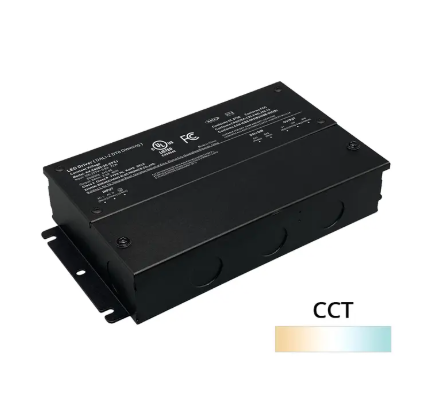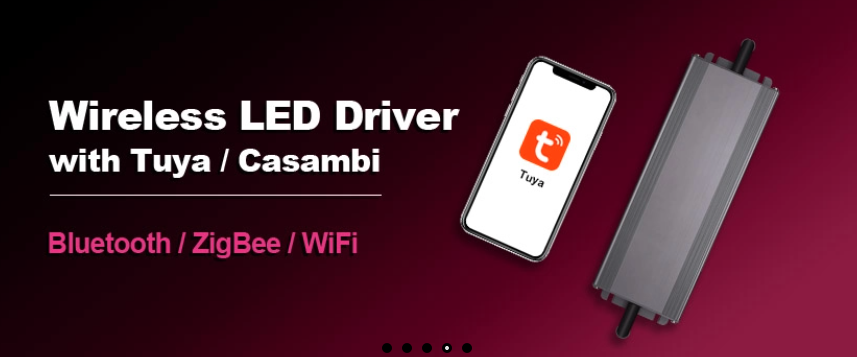Flickering lights, uneven brightness, sudden shutdowns, overheating drivers — these are just a few of the common LED driver power issues that can disrupt your lighting system. Left unchecked, such problems can lead to higher energy consumption, shortened LED lifespan, unexpected maintenance costs, and even complete lighting failure.
Because the LED driver regulates the voltage and current that your LEDs receive, any malfunction directly impacts performance and reliability. In this guide, we’ll break down the most frequent LED driver issues, explain how to diagnose them, and share proven troubleshooting steps. By understanding the root causes and applying preventive measures, you can keep your LED lighting running efficiently and avoid costly downtime.

Common LED Driver Power Issues
Flickering or Flashing LED Lights
Causes: Unstable current, incompatible dimmer, power fluctuations.
Symptoms: Intermittent flashing or flickering of LED lights.
How to Identify: Check for voltage fluctuations using a multimeter. Verify that the dimmer is compatible with the LED driver.
Inconsistent Brightness
Causes: Incorrect voltage output, degraded components, temperature effects.
Symptoms: Variations in brightness levels, especially in LED strips.
How to Identify: Measure the output voltage with a multimeter. Inspect the driver and LED connections for signs of wear or damage.
Short Lifespan of LED Lights
Causes: Overdriving LEDs, excessive current, heat-related issues.
Symptoms: LEDs burning out quickly or experiencing reduced brightness over time.
How to Identify: Measure the output current to ensure it matches the LED specifications. Check for signs of overheating, such as excessive heat or discoloration.
Overheating Issues
Causes: Poor ventilation, high operating temperature, small lamp interior.
Symptoms: Excessive heat, reduced performance, or driver shutdown.
How to Identify: Evaluate the ventilation around the driver. Use a thermal imaging camera to check for hot spots.
LED Lights Not Turning On
Causes: Possible driver power supply failure.
Symptoms: LEDs do not turn on, even when power is supplied.
How to Identify: Verify input power using a multimeter. Test the driver output voltage to ensure it is within the specified range.
LED Lights Turning Off Unexpectedly
Causes: Overheating, intermittent voltage supply, driver internal fault.
Symptoms: LEDs turning off without warning.
How to Identify: Check for thermal protection triggers. Inspect power fluctuations using a multimeter.
LED Lights Not Dimming Properly
Causes: Incompatibility between driver and dimmer.
Symptoms: Dimming does not work as expected, or LEDs flicker during dimming.
How to Identify: Verify driver-dimmer compatibility. Test with a different dimmer if possible.
LED Driver Noise Issues
Causes: Magnetic transformer humming or buzzing.
Symptoms: Audible humming or buzzing noise from the driver.
How to Identify: Identify the type of transformer used. Replace with an electronic transformer driver if necessary.
Compatibility Issues
Causes: Driver vs. LED vs. power supply compatibility problems.
Symptoms: Poor performance, flickering, or non-functioning LEDs.
How to Identify: Confirm that the driver, LED, and power supply ratings match. Consider using certified drivers that comply with standards.

Troubleshooting LED Driver Power Issues
Safety Precautions Before Troubleshooting
Before attempting any troubleshooting, it is crucial to follow safety precautions to avoid electrical hazards:
Disconnect Power: Always disconnect the power supply before working on the driver or LED system. This step is essential to prevent electric shock and damage to the components. Use a multimeter to verify that there is no voltage present at the driver terminals.
Use Proper Tools: Ensure you have the appropriate tools for the task. A multimeter is essential for measuring voltage and current. Additionally, insulated screwdrivers and pliers can help prevent accidental short circuits. Having a continuity tester can also be useful for checking connections.
Avoid Live Circuits: Never touch live circuits or components. Working on live circuits can lead to severe electric shocks and potential damage to the LED system. Always ensure the power is off and the system is properly grounded.
Step-by-Step Troubleshooting Guides
Flickering or Flashing
Check Input Voltage: Use a multimeter to verify that the input voltage is within the specified range. Fluctuations in input voltage can cause instability in the driver’s output, leading to flickering. Ensure the input voltage matches the driver’s specifications (e.g., 120V AC, 220V AC, or 277V AC).
Verify Driver Output: Measure the output voltage and current to ensure they match the LED specifications. Inconsistent output can be a sign of a failing driver. Compare the measured values with the manufacturer’s specifications to identify any discrepancies.
Replace Driver if Needed: If the output is unstable or out of range, consider replacing the driver. A faulty driver can cause significant issues with LED performance. Ensure the new driver is compatible with your LED system and meets the required specifications.
Inconsistent Brightness
Measure Output Voltage: Use a multimeter to check the output voltage. Inconsistent brightness can be caused by voltage fluctuations. Ensure the output voltage is stable and within the specified range for your LEDs.
Inspect Connections: Ensure all connections between the driver and LEDs are secure. Loose or corroded connections can lead to voltage drops and inconsistent brightness. Clean and tighten any loose connections.
Replace Driver if Voltage Out of Range: If the voltage is inconsistent, replace the driver. A new driver can provide a stable output, ensuring consistent brightness across all LEDs.
Short Lifespan
Measure Output Current: Verify that the output current matches the LED specifications. Overdriving LEDs with excessive current can significantly reduce their lifespan. Use a multimeter to measure the current and ensure it is within the specified range.
Check for Overdriving or Overheating: Ensure the driver is not supplying excessive current or operating at high temperatures. Overheating can cause premature failure of both the driver and the LEDs. Check for signs of overheating, such as excessive heat or discoloration.
Replace Driver or Adjust Design Parameters: If necessary, replace the driver or adjust the system design to prevent overdriving. Consider using a driver with a higher current rating or improving the thermal management of your system.
Overheating
Evaluate Ventilation and Lamp Temperature: Ensure adequate airflow around the driver and LEDs. Poor ventilation can cause the driver to overheat, leading to reduced performance and potential failure. Use fans or heat sinks to improve airflow if necessary.
Consider Higher Temperature-Rated Driver: If overheating persists, consider using a driver rated for higher temperatures. High-temperature-rated drivers are designed to operate efficiently in warmer environments.
Test Driver After Replacement: Verify that the new driver operates within the specified temperature range. Use a thermal imaging camera to check for hot spots and ensure the driver is functioning correctly.
Lights Not Turning On
Verify Input Power: Use a multimeter to confirm that power is reaching the driver. Check the input voltage to ensure it matches the driver’s specifications. Ensure all connections are secure and free from damage.
Test Driver Output Voltage: Measure the output voltage to ensure it is within the specified range. A lack of output voltage indicates a potential driver failure. Compare the measured voltage with the manufacturer’s specifications.
Replace Driver if Malfunctioning: If the output voltage is incorrect, replace the driver. A malfunctioning driver can prevent the LEDs from receiving power, causing them to remain off.
Unexpected Shutdown
Check for Thermal Protection Triggers: Verify that the driver is not overheating. Thermal protection mechanisms can cause the driver to shut down if it reaches a critical temperature. Ensure proper ventilation and consider using a higher temperature-rated driver.
Inspect Power Fluctuations: Use a multimeter to check for voltage fluctuations. Intermittent power supply issues can cause the driver to shut down unexpectedly. Ensure the input voltage is stable and within the specified range.
Replace Driver if Persistent: If the issue persists, consider replacing the driver. A faulty driver may not be able to handle the required load or voltage fluctuations, leading to unexpected shutdowns.
Dimming Problems
Verify Driver-Dimmer Compatibility: Ensure the driver and dimmer are compatible. Incompatibility between the driver and dimmer can cause dimming issues, such as flickering or inconsistent brightness. Refer to the manufacturer’s specifications to ensure compatibility.
Replace with Compatible Dimmable Driver: If necessary, replace the driver with one that is compatible with your dimmer. Using a compatible dimmable driver can resolve dimming issues and provide smooth brightness control.
Noise Issues
Identify Type of Transformer: Determine if the driver uses a magnetic transformer. Magnetic transformers can produce audible humming or buzzing noise, especially under load.
Replace Magnetic Transformer Driver with Electronic Transformer Driver: If noise is an issue, consider switching to an electronic transformer driver. Electronic drivers are generally quieter and more efficient, reducing noise and improving performance.
Compatibility Checks
Confirm Driver, LED, and Power Supply Ratings: Ensure all components are compatible. Mismatched ratings can lead to poor performance, flickering, or non-functioning LEDs. Verify that the driver’s output matches the LED’s requirements and that the power supply can handle the total load.
Consider Certified Drivers for CE, UL, SAA Compliance: Use drivers that meet relevant certification standards. Certified drivers ensure safety, reliability, and compliance with international standards. This can help prevent issues related to voltage fluctuations, overheating, and component failure.
By following these detailed troubleshooting steps and safety precautions, you can effectively identify and resolve common LED driver power issues, ensuring your LED lighting system operates efficiently and reliably.
Preventing LED Driver Power Issues
Proper Installation and Ventilation
Ensure adequate airflow around the driver and LEDs to prevent overheating. Avoid installing drivers in enclosed spaces that trap heat.
Regular Maintenance and Checks
Periodically check the input and output voltage and current to ensure they are within the specified ranges. Inspect connections and drivers for signs of wear or damage.
Choosing the Right Driver
Match the driver’s voltage, current, and dimming capabilities with the LED specifications. Consider using certified drivers for safety and reliability.
Conclusion
Troubleshooting LED driver power issues is essential for maintaining the performance and longevity of your LED lighting system. By understanding common issues, following detailed troubleshooting steps, and implementing preventive measures, you can ensure your LED system operates efficiently and reliably. Proper driver selection, maintenance, and compatibility are key to avoiding future problems. Always follow safety precautions and consult professionals when necessary to ensure the best results.
















